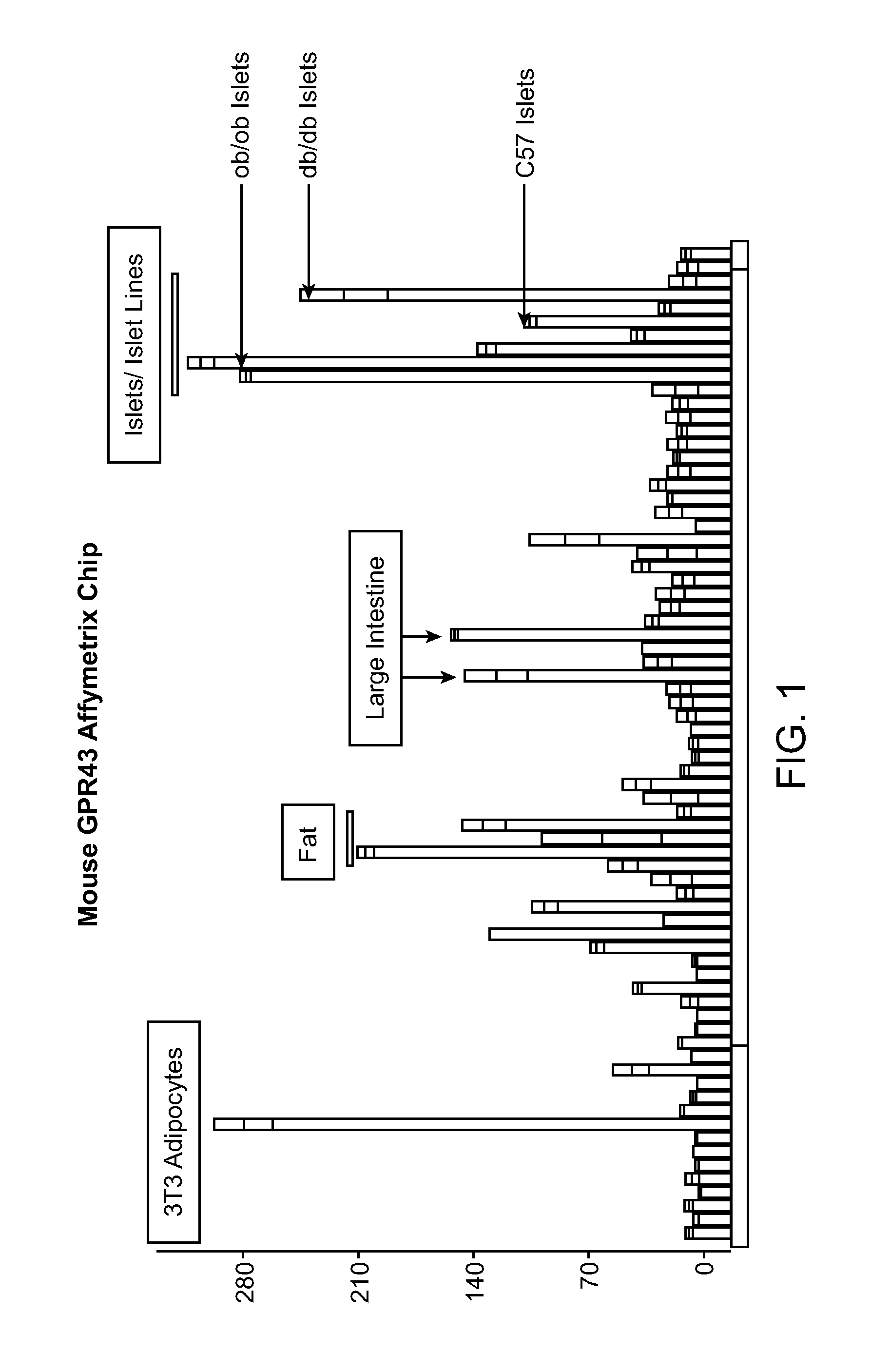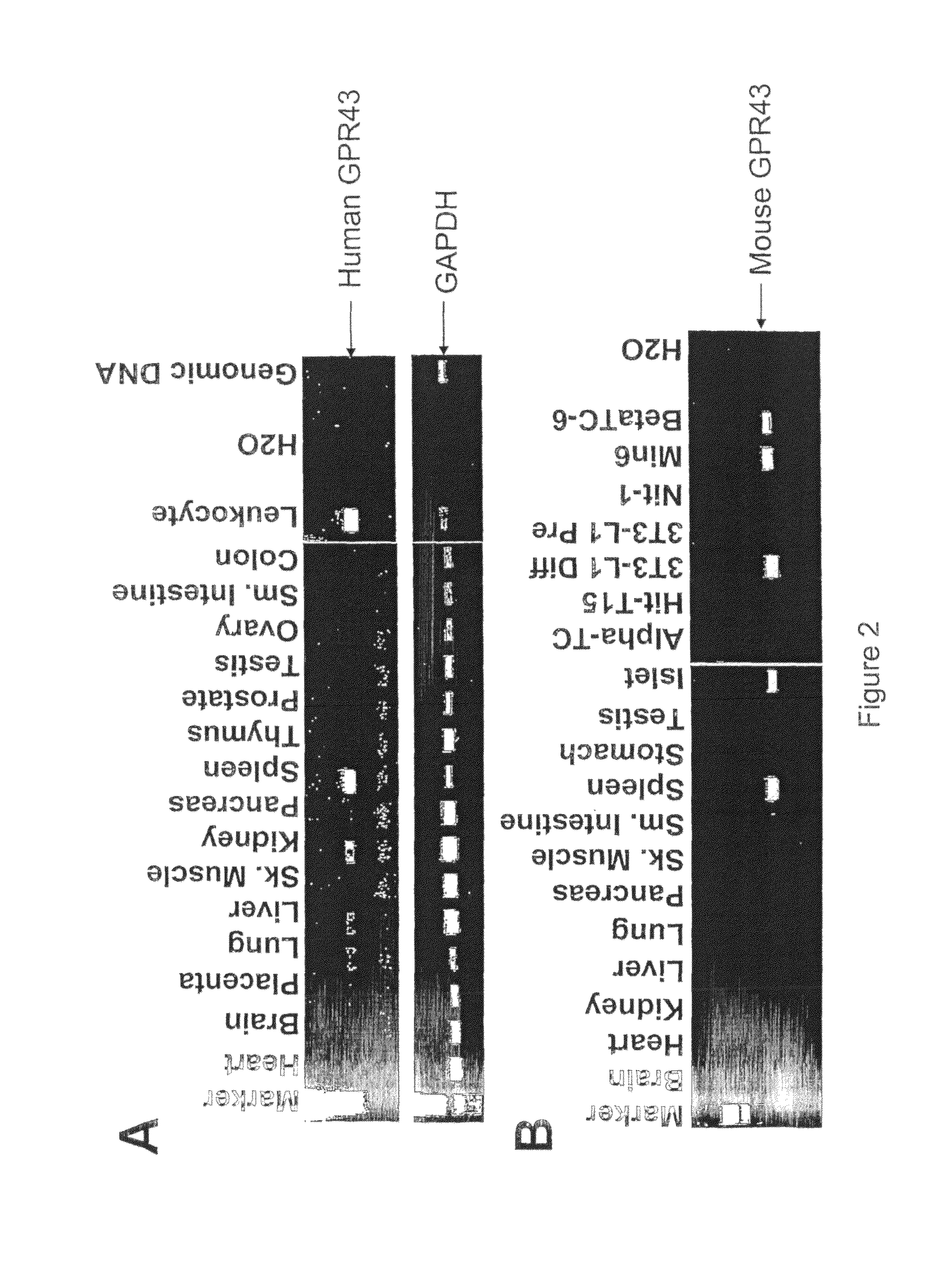Method of screening for compounds useful in the treatment of insulin resistance, impaired glucose tolerance or diabetes
a screening method and technology for compounds, applied in the direction of peptide/protein ingredients, instruments, metabolism disorders, etc., can solve the problems of increased blood glucose levels observed in diabetics, increased blood glucose levels in diabetics, and impaired glucose tolerance, and achieve the effect of reducing the function of gpr43
- Summary
- Abstract
- Description
- Claims
- Application Information
AI Technical Summary
Benefits of technology
Problems solved by technology
Method used
Image
Examples
example 1
Affymetrix Chip Analysis of Mouse GPR43 Expression in Mouse Adult and Fetal Tissues and Cells
[0228]In this example, the expression level of mouse GPR43 was determined in several mouse adult and fetal tissues and cells using an Affymetrix gene chip (from left to right: fetal brain, pons spinal cord, spinal cord lower, SN pons thalamus, olfactory bulb, thalamus, hippocampus, swiss-3T3, 3T3-LI adipocyte, BV2+LPS 24 hr, NIH-3T3, 3T3-LI preadipocvte, NIT-1, N1E-115 differentiated, E14TG2A, BV2, N1E-115, BV2+LPS 4 hr, NIT CTL, C57BL6 ES, D3 ES, lymph node, bone marrow, T-cells, CD4+ ovalbumin, spleen, T-cells, CD4+ naive, thymus, duodenum, skin fat, brown fat, epididimal fat, ventricle, atria, aorta, fibroblast, neonatal cardiac, ventricular myocytes, hypoxia-reoxyg, neonatal, ventricular myocytes, normoxia, neonatal, ventricular myocytes, ventricular myocytes, hypoxia, neonatal, ventricle, left TAC, ventricle, left sham, large intestine proximal, stomach fondues, small intestine, large i...
example 2
RT-PCR Analysis of GPR43 Expression in Human and Mouse Tissues and Cells
[0233]In this example, the expression level of human and mouse GPR43 was determined in several human and mouse tissues and cell types using an RT-PCR assay. As shown in FIG. 2, top panel, human GPR43 gene expression was observed in several human tissues and cells including, for example, placenta lung, liver, kidney, pancreas, spleen, prostate and leukocytes. In addition, as shown in FIG. 2, bottom panel, mouse GPR43 gene expression was observed in several mouse tissues, cells and cell lines, including, for example, lung, pancreas, skeletal muscle, small intestine, spleen, stomach, islets 3T3-L1 differentiated adipocytes, Nit-1 cells, Min6 cells and beta TC-6 cells.
[0234]For this experiment, human cDNAs were obtained from Human MTC Panel I and Human MTC Panel II (Clontech). Mouse Poly A+RNAs were obtained from Clontech. Subsequently, cDNAs were synthesized with iScript cDNA Synthesis Kit (Bio-Rad) according to th...
example 3
Identification of GPR43 Modulators
[0239]In this example, GPR43 modulators are identified using a screening protocol in melanophores.
1. Melanophore Technology
[0240]Melanophores are skin cells found in lower vertebrates. They contain pigmented organelles termed melanosomes. Melanophores are able to redistribute these melanosomes along a microtubule network upon G-protein coupled receptor (GPCR) activation. The result of this pigment movement is an apparent lightening or darkening of the cells. In melanophores, the decreased levels of intracellular cAMP that result from activation of a Gi-coupled receptor cause melanosomes to migrate to the center of the cell, resulting in a dramatic lightening in color. If cAMP levels are then raised, following activation of a Gs-coupled receptor, the melanosomes are re-dispersed and the cells appear dark again. The increased levels of diacylglycerol that result from activation of Gq-coupled receptors can also induce this re-dispersion. In addition, t...
PUM
| Property | Measurement | Unit |
|---|---|---|
| dissociation constant | aaaaa | aaaaa |
| dissociation constant | aaaaa | aaaaa |
| dissociation constant | aaaaa | aaaaa |
Abstract
Description
Claims
Application Information
 Login to View More
Login to View More - R&D
- Intellectual Property
- Life Sciences
- Materials
- Tech Scout
- Unparalleled Data Quality
- Higher Quality Content
- 60% Fewer Hallucinations
Browse by: Latest US Patents, China's latest patents, Technical Efficacy Thesaurus, Application Domain, Technology Topic, Popular Technical Reports.
© 2025 PatSnap. All rights reserved.Legal|Privacy policy|Modern Slavery Act Transparency Statement|Sitemap|About US| Contact US: help@patsnap.com


